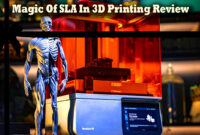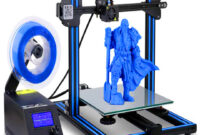SLA 3D Printing: Uncovering Its Mechanisms and Benefits-In the field of additive manufacturing or 3D printing, Stereolithography, commonly known as SLA 3D printing, is a leading method alongside FDM and SLS technologies. By using high-power lasers to solidify liquid resin, SLA 3D printing presents an exciting avenue for creating complex three-dimensional shapes.
Exploring SLA 3D Printing Components
Hello everyone, did you know that every SLA 3D printer consists of basic components, including:
- A reservoir filled with liquid resin.
- The hollow platform is submerged in a reservoir, capable of moving vertically during the printing process.
- High power ultraviolet laser.
- Interface engine that controls the movement of platforms and lasers.
- SLA 3D Printing Mechanism:
The essence of SLA 3D printing lies in the interaction between laser and liquid resin to materialize objects. Here’s a breakdown of how SLA 3D printing is done:

Design Phase:
Starting the process involves creating the desired shape using software, usually requiring converting the design to Standard Tessellation Language (STL) format, describing the surface geometry of the object to simplify printing.
Printing Procedure:
Once initiated, the laser carefully traces the initial layers of the object into the photosensitive resin. Upon contact with the laser, the resin undergoes polymerization, hardening into the desired shape. Guided by a computer-controlled mirror, the laser targets precise coordinates. In particular, SLA printers often operate in reverse, with the laser initially aimed at the manufacturing platform and gradually working its way up.
Next, as each layer forms, the platform rises according to the thickness of the layer, allowing fresh resin to seep beneath the developing part. The laser then compacts the next section. This iterative process continues until the entire object is complete, with any unused resin remaining in the reservoir for reuse.
Post processing:
After polymerization, the finished 3D object exits the resin tank, undergoes cleaning to remove residual liquid, and proceeds to a UV oven for the final curing process. This final stage fortifies the structure, increasing its strength and stability.
Benefits of SLA 3D Printing
The appeal of SLA 3D printing stems from its numerous advantages, which differentiate it from alternative methods:
Precision and Accuracy:
Operating at lower temperatures compared to thermoplastic-based technologies, SLA printers maintain temperatures close to room temperature, thereby reducing thermal expansion or contraction. As a result, SLA printed objects exhibit exceptional precision and accuracy.
Superior Surface Finish:
SLA printers produce objects with a very smooth surface finish, ideal for applications that require perfect aesthetics. These characteristics not only reduce post-processing time but also enable easy sanding, polishing and painting for optimal usability.
SLA 3D printing represents the fascinating world of additive manufacturing, offering complexity, precision and surface quality unmatched by conventional methods. Visit our website to gain further insight into the world of plastic. For plastic industry professionals, Tokoplas offers a complete range of plastic raw materials, meeting a variety of needs ranging from PE, PP, PS, PET, EVA, PC, ABS, Nylon, recycled plastic pellets, plastic additives, plastic films and plastic pallets .


